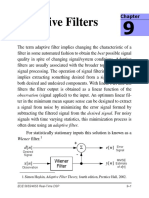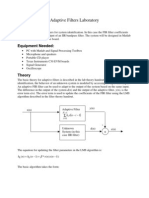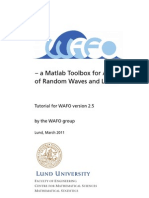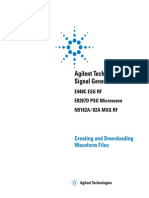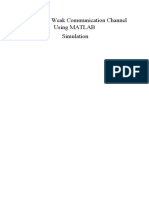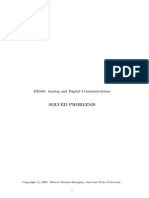Signal To Noise Ratio Using MATLAB
Uploaded by
MatlabAsignmentExpertsSignal To Noise Ratio Using MATLAB
Uploaded by
MatlabAsignmentExpertsSIGNAL TO NOISE RATIO USING MATLAB (SAMPLE ASSIGNMENT) For any Help with Signal to Noise Ratio Assignment
upload your Homework Assignment by clicking at Submit Your Assignment button or you can email it to info@matlabassignmentexperts.com .To talk to our Online Signal to Noise Ratio Project Tutors you can call at +1 5208371215 or use our Live Chat option.
Cross-correlation of Delayed Signal in Noise
This sample assignment shows how to use the cross-correlation sequence to detect the time delay in a noisecorrupted sequence. The output sequence is a delayed version of the input sequence with additive white Gaussian noise. Create two sequences. One sequence is a delayed version of the other. The delay is 3 samples. Add an N(0,0.32) white noise sequence to the delayed signal. Use the sample cross-correlation sequence to detect the lag. Create and plot the signals. Set the random number generator to the default settings for reproducible results.
rng default; x = triang(20); y = [zeros(3,1); x]+0.3*randn(length(x)+3,1); subplot(211) stem(x,'markerfacecolor',[0 0 1]); axis([0 22 -1 2]); subplot(212) stem(y,'markerfacecolor',[0 0 1]); axis([0 22 -1 2]);
Obtain the sample cross-correlation sequence and use the maximum absolute value to estimate the lag. Plot the sample cross-correlation sequence.
[xc,lags] = xcorr(y,x); [~,I] = max(abs(xc)); fprintf('Maximum cross correlation sequence value occurs at lag %d\n',lags(I)); figure; stem(lags,xc,'markerfacecolor',[0 0 1]);
The maximum cross correlation sequence value occurs at lag 3 as expected.
You might also like
- Carrier Recovery Using A Second Order Costas LoopNo ratings yetCarrier Recovery Using A Second Order Costas Loop25 pages
- Equalization: Digital Communications USING MATLAB (SAMPLE ASSIGNMENT)100% (2)Equalization: Digital Communications USING MATLAB (SAMPLE ASSIGNMENT)7 pages
- MATLAB For Audio Signal Processing: P. Professorson UT Arlington Night SchoolNo ratings yetMATLAB For Audio Signal Processing: P. Professorson UT Arlington Night School27 pages
- Filter Implementation and Evaluation Using MatlabNo ratings yetFilter Implementation and Evaluation Using Matlab14 pages
- FSO Simulation Using MATLAB By: Mojtaba Mansour Abadi Date: 03 September 2018No ratings yetFSO Simulation Using MATLAB By: Mojtaba Mansour Abadi Date: 03 September 20188 pages
- Underwater Communications: Milica Stojanovic Massachusetts Institute of Technology Millitsa@mit - EduNo ratings yetUnderwater Communications: Milica Stojanovic Massachusetts Institute of Technology Millitsa@mit - Edu16 pages
- Notes On Power Spectral Density (PSD) Estimation Using Matlab100% (1)Notes On Power Spectral Density (PSD) Estimation Using Matlab10 pages
- Communication Channel Design Using MATLAB SimulationNo ratings yetCommunication Channel Design Using MATLAB Simulation30 pages
- List of Functions Involving The Error FunctionNo ratings yetList of Functions Involving The Error Function20 pages
- Matlab Based Radar System, Utilizing Correlation: Saifullah AminNo ratings yetMatlab Based Radar System, Utilizing Correlation: Saifullah Amin11 pages
- Sinusoidal Synthesis of Speech Using MATLABNo ratings yetSinusoidal Synthesis of Speech Using MATLAB35 pages
- Understanding FFTs and Windowing - National InstrumentsNo ratings yetUnderstanding FFTs and Windowing - National Instruments10 pages
- Electromagnetic Waves and Radiating Systems 2nd Ed82% (57)Electromagnetic Waves and Radiating Systems 2nd Ed774 pages
- Matlab For Microeconometrics: Numerical Optimization: Nick Kuminoff Virginia Tech: Fall 2008No ratings yetMatlab For Microeconometrics: Numerical Optimization: Nick Kuminoff Virginia Tech: Fall 200816 pages
- Revision On MATLAB & Image Processing With MatlabNo ratings yetRevision On MATLAB & Image Processing With Matlab36 pages
- Solved Problems: EE160: Analog and Digital Communications100% (1)Solved Problems: EE160: Analog and Digital Communications145 pages
- Transmission Lines in Digital and Analog Electronic Systems: Signal Integrity and CrosstalkFrom EverandTransmission Lines in Digital and Analog Electronic Systems: Signal Integrity and CrosstalkNo ratings yet
- Cross Design Using Matlab (Sample Assignment)No ratings yetCross Design Using Matlab (Sample Assignment)3 pages
- CMP4101 Signal Analysis in the Time DomainNo ratings yetCMP4101 Signal Analysis in the Time Domain28 pages
- Measuring Signal Similarities - MATLAB & Simulink ExampleNo ratings yetMeasuring Signal Similarities - MATLAB & Simulink Example12 pages
- Course Title: Digital Signal Processing I Lab Course Code: EEE 314No ratings yetCourse Title: Digital Signal Processing I Lab Course Code: EEE 3143 pages
- Experiment No. 2A Correlation of SignalsNo ratings yetExperiment No. 2A Correlation of Signals10 pages
- Transmitter Subsystem Using Matlab (Sample Assignment)No ratings yetTransmitter Subsystem Using Matlab (Sample Assignment)4 pages
- Simulate Conditional Variance Model: Simulating The System in Matlab (Sample Assignment)No ratings yetSimulate Conditional Variance Model: Simulating The System in Matlab (Sample Assignment)3 pages
- PI Controller in The Simulink Model Using MATLABNo ratings yetPI Controller in The Simulink Model Using MATLAB9 pages
- Simulating The Levitation System Using MATLABNo ratings yetSimulating The Levitation System Using MATLAB3 pages
- Cell vs. Struct Arrays: Plot of Data Vs Time in Matlab (Sample Assignment)No ratings yetCell vs. Struct Arrays: Plot of Data Vs Time in Matlab (Sample Assignment)2 pages
- Hopfield Three Neuron Design: Network Design Using Matlab (Sample Assignment)No ratings yetHopfield Three Neuron Design: Network Design Using Matlab (Sample Assignment)5 pages
- Links Design Using Matlab (Sample Project Code)No ratings yetLinks Design Using Matlab (Sample Project Code)4 pages
- Design of A Lead Controller Using Matlab (Sample: Assignment)No ratings yetDesign of A Lead Controller Using Matlab (Sample: Assignment)2 pages
- Design at 10Gbps Using Matlab (Sample Assignment)No ratings yetDesign at 10Gbps Using Matlab (Sample Assignment)7 pages
- Antenna With Custom Radiation: Antenna Physical Design Using Matlab (Sample Assignment)No ratings yetAntenna With Custom Radiation: Antenna Physical Design Using Matlab (Sample Assignment)1 page








